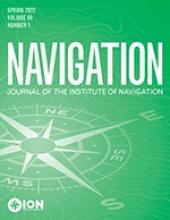Research ArticleOriginal Article
Open Access
Improved Automatic Detection of GPS Satellite Oscillator Anomaly using a Machine Learning Algorithm
Yunxiang Liu, and Y. Jade Morton
NAVIGATION: Journal of the Institute of Navigation March 2022, 69 (1) navi.500; DOI: https://doi.org/10.33012/navi.500
Yunxiang Liu,
Smead Aerospace Engineering Sciences Department, University of Colorado, Boulder Boulder, CO, USA
Y. Jade Morton
Smead Aerospace Engineering Sciences Department, University of Colorado, Boulder Boulder, CO, USA

REFERENCES
- ↵
- Benton, C. J., &
- Mitchell, C. N.
- ↵
- Benton, C. J., &
- Mitchell C. N.
- ↵
- Bishop, C.
- ↵
- Blanch, J.,
- Walter, T.,
- Enge, P.,
- Wallner, S.,
- Fernandez, F. A.,
- Dellago, R.,
- Ioannides, R.,
- Hernandez, I. F.,
- Belabbas, B., &
- Rippl, M.
- ↵
- Breiman, L.
- ↵
- Carrano, C. S.,
- Groves, K. M.,
- McNeil, W. J., &
- Doherty, P. H.
- ↵
- Chang, C.-C. &
- Lin, C.-J.
- ↵
- Cobb, H. S.,
- Lawrence, D.,
- Christie, J.,
- Walter, T.,
- Chao, Y. C.,
- Powell, J. D., &
- Parkinson, B.
- Cournapeau, D.
- ↵
- Fernández-Delgado, M.,
- Cernadas, E.,
- Barro, S., &
- Amorim, D.
- ↵
- Gordon, S.,
- Shallberg, K.,
- Ericson, S.,
- Grabowski, J.,
- Morrissey, T., &
- Lorge, F.
- ↵
- Hansen, A.,
- Walter, T.,
- Enge, P., &
- Lawrence, D.
- ↵
- Heng, L.
- ↵
- Heo, Y.-J.,
- Cho, J.-H., &
- Heo, M.-B.
- ↵
- Jiao, Y.
- ↵
- Jiao, Y.,
- Hall, J. J., &
- Morton, Y. T.
- ↵
- Jiao, Y.,
- Hall, J. J., &
- Morton, Y. T.
- ↵
- Liu, Y., &
- Morton, Y.
- ↵
- Liu, Y., and
- Morton, Y. J.
- ↵
- Liu, Y., &
- Morton, Y. J.
- ↵
- Lockheed Martin
- ↵
- McCaffrey, A. M., &
- Jayachandran, P. T.
- ↵
- Morton, Y. J.,
- Yang, Z.,
- Breitsch, B.,
- Borne, H., &
- Rino, C.
- ↵
- Quinlan, J. R.
- ↵
- Ramesh, R. K. H.,
- Ugazio, S., &
- van Graas, F.
- ↵
- Shallberg K., &
- Sheng, F.
- ↵
- Van Dierendonck, A. J.,
- Klobuchar, J., &
- Hua, Q.
- ↵
- Vary, N.
- ↵
- Vioarsson, L.,
- Pullen, S.,
- Green, G., &
- Enge, P.
- ↵
- Walter, T.,
- Blanch, J.,
- Phelts, R. E., and
- Enge, P.
- ↵
- Walter, T.,
- Enge, P., &
- DeCleene, B.
- ↵
- Weiss, M.,
- Shome, P., &
- Beard, R.
- ↵
- Yang, H.,
- Xu, C., &
- Gao, Y.
In this issue
NAVIGATION: Journal of the Institute of Navigation
Vol. 69, Issue 1
Spring 2022
Improved Automatic Detection of GPS Satellite Oscillator Anomaly using a Machine Learning Algorithm
Yunxiang Liu,, Y. Jade Morton
NAVIGATION: Journal of the Institute of Navigation Mar 2022, 69 (1) navi.500; DOI: 10.33012/navi.500
Jump to section
Related Articles
Cited By...
- No citing articles found.






